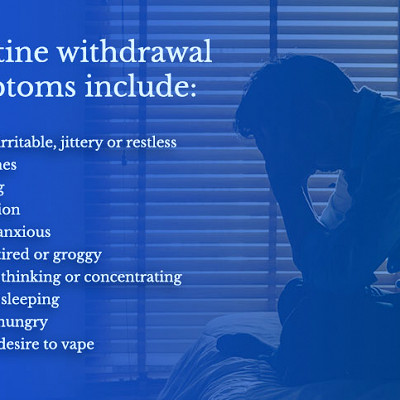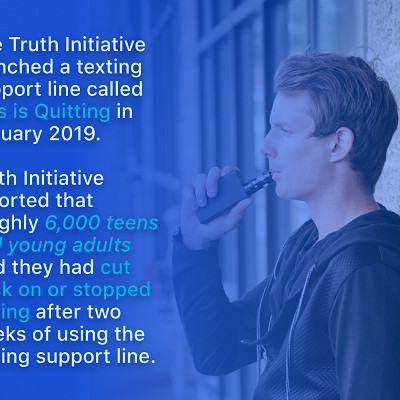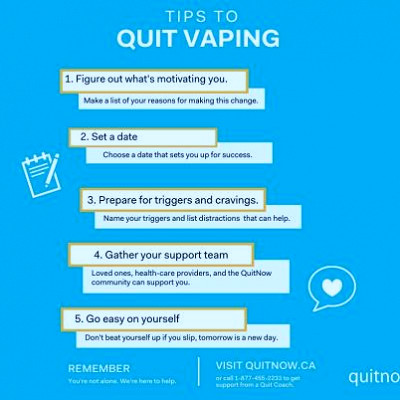 Jarlat Maletych/Shutterstock
Jarlat Maletych/Shutterstock
Features
Understanding the Addiction
It's important to understand that vaping is more than just a habit; it's an addiction. Nicotine, the main active ingredient in e-cigarettes, is a highly addictive substance. Recognizing this can help frame the quitting process as a journey of overcoming addiction, rather than simply breaking a habit.
Setting a Quit Date
Setting a specific quit date gives you a concrete goal to work towards. This can provide motivation and a sense of urgency. Choose a date that isn’t too far in the future so that it doesn’t seem unattainable.
Nicotine Replacement Therapy (NRT)
NRT, such as patches, gum, and lozenges, can help to alleviate withdrawal symptoms. They provide a controlled dose of nicotine to ease the transition away from vaping.
Cognitive Behavioral Therapy (CBT)
CBT can help you to identify the triggers that lead you to vape and develop coping strategies to avoid them. This form of therapy can be particularly effective in combination with NRT.
Physical Activity
Regular exercise can help to reduce cravings and ease withdrawal symptoms. It also promotes overall wellness and can help to fill the void left by vaping.
Support Networks
Joining a support group or enlisting the help of friends and family can provide emotional backing and motivation. Having others who understand your struggles and can offer encouragement can make a significant difference.
Mindful Eating
Nicotine withdrawal can cause cravings for sweet foods. By practicing mindful eating, you can ensure you’re meeting your nutritional needs without resorting to unhealthy snacking.
Meditation and Relaxation Techniques
Practices like yoga, deep breathing, and meditation can help manage stress and anxiety that may come with quitting. These techniques can also help manage cravings.
Gradual Reduction
Instead of quitting all at once, some people find it helpful to gradually reduce the amount of nicotine they consume. This can help to lessen withdrawal symptoms.
Medication
Certain prescription medications can help to reduce cravings and withdrawal symptoms. Speak with your healthcare provider to see if this might be a good option for you.
Journaling
Keeping a journal can help you track your progress and identify triggers. It can also serve as a therapeutic outlet for your thoughts and feelings.
Hydration
Drinking plenty of water can help to flush the nicotine out of your system quicker, reducing withdrawal symptoms.
Sleep
Adequate sleep is vital for your overall health and can help your body recover from the effects of nicotine withdrawal.
Avoiding Triggers
If certain situations or environments make you want to vape, it can be helpful to avoid them, at least in the early stages of quitting.
Healthy Reward System
Reward yourself with non-food treats for reaching milestones in your quit journey. This can provide additional motivation.
Professional Help
If you're struggling to quit on your own, consider seeking professional help. Addiction specialists can provide guidance and strategies tailored to your unique situation.
Digital Detox
As much of vaping culture exists online, taking a break from social media and digital platforms that promote vaping can be beneficial.
Understanding Relapse
Relapse is a common part of the quit journey. Instead of viewing it as a failure, see it as an opportunity to learn and refine your quit strategy.
Patience
Quitting vaping is a process that takes time. Be patient with yourself and recognize that progress may be slow but is still significant.
Overall Health
Remember that quitting vaping is just one part of improving your overall health. Incorporate other healthy habits into your life, such as a balanced diet and regular exercise, to maximize your wellness.
Interesting notes and facts
1. Understanding Your Addiction: Vaping is addictive because it contains nicotine. Just like cigarettes, e-cigarettes can lead to a strong dependency. Recognizing this as an addiction, and not just a habit, is the first step toward quitting. Once you're aware of the hold it has on you, you can start to tackle it head-on.2. Set a Quit Date: Giving yourself a deadline can make the process of quitting more manageable. Choose a date that's meaningful to you, like a birthday or anniversary, to give you extra motivation. On this date, you'll stop using your vape completely.
3. Find a Support Network: Quitting vaping can be tough. Don't try to do it alone. Reach out to friends, family, or a support group who can offer encouragement and help you through the tough times. There are also hotlines and online resources available to provide support and guidance.
4. Reduce Nicotine Gradually: Going cold turkey isn't for everyone. If the thought of completely stopping scares you, try reducing your nicotine levels gradually. This can help to lessen withdrawal symptoms and make the transition easier.
5. Keep Your Hands and Mouth Busy: A lot of the addiction to vaping is tied to the physical act. Keeping your hands and mouth busy can help you deal with the cravings. Try chewing gum, snacking on healthy foods, or occupying your hands with a stress ball or fidget spinner.
6. Exercise Regularly: Regular physical activity can help reduce your cravings and withdrawal symptoms. It also helps to boost your mood and keep you motivated.
7. Stay Hydrated: Drinking plenty of water can help manage cravings and also flush the nicotine out of your system faster. Try to make water your drink of choice, and keep a bottle with you at all times.
8. Know Your Triggers: Certain situations or emotions might trigger your urge to vape. Identify these triggers and develop a plan to handle them. This could include practicing deep breathing, going for a walk, or calling a friend for a chat.
9. Think About the Benefits: Keep reminding yourself why you want to quit. Think about the health benefits, the money you'll save, and how much better you'll feel. Write these reasons down and keep them somewhere you can see them regularly.
10. Don't Get Discouraged: Quitting vaping can be tough, and it's common to have setbacks. If you slip up, don't beat yourself up. Just get back on track as soon as you can. Remember, every step you take towards quitting is a step towards a healthier you.
Vocabulary
- Vaping – The act of inhaling and exhaling the aerosol, produced by an e-cigarette or similar device.
- E-cigarette – A handheld battery-powered vaporizer that simulates smoking, but without tobacco combustion.
- Nicotine – A stimulant and potent parasympathomimetic alkaloid that is naturally produced in the nightshade family of plants.
- Withdrawal – The combination of physical and mental effects that a person experiences after they stop using or reduce their intake of a substance such as alcohol and prescription or recreational drugs.
- Craving – A powerful desire for something.
- Addiction – A psychological and physical inability to stop consuming a chemical, drug, activity, or substance, even though it is causing psychological and physical harm.
- Support Group – A group of people with common experiences or concerns who provide each other with encouragement, comfort, and advice.
- Therapy – Treatment intended to relieve or heal a disorder.
- Nicotine Replacement Therapy (NRT) – A medically-approved way to take nicotine by means other than tobacco to help you quit smoking.
- Counseling – The process of assisting and guiding clients, especially by a trained person on a professional basis, to resolve personal, social, or psychological problems and difficulties.
- Healthy Diet – A balanced diet that includes all necessary nutrients and vitamins.
- Physical Exercise – Any bodily activity that enhances or maintains physical fitness and overall health and wellness.
- Hydration – Taking in fluids so as to prevent dehydration.
- Stress Management – Techniques intended to equip a person with effective coping mechanisms for dealing with psychological stress.
- Cold Turkey – The abrupt cessation of a substance dependency for which a person has developed a tolerance and dependence.
- Nicotine Gum – A type of chewing gum that delivers nicotine to the body.
- Nicotine Patch – A transdermal patch that releases nicotine into the body through the skin.
- Nicotine Lozenge – A tablet (usually flavored) that contains a dose of nicotine polacrilex, which dissolves slowly in the mouth to release the nicotine over the course of 20 to 30 minutes.
- Nicotine Inhaler – A device that gives a specific amount of nicotine which gets absorbed through the lining of your mouth and throat.
- Nicotine Nasal Spray – A prescription medication that helps people stop smoking by reducing cravings and nicotine withdrawal symptoms.
- Behavioral Therapy – A type of psychotherapy that aims to identify and help change potentially self-destructive or unhealthy behaviors.
- Cognitive-Behavioral Therapy (CBT) – A form of psychological treatment that has been demonstrated to be effective for a range of problems including depression, anxiety disorders, alcohol and drug use problems, marital problems, eating disorders, and severe mental illness.
- Mindfulness – A mental state achieved by focusing one's awareness on the present moment, while calmly acknowledging and accepting one's feelings, thoughts, and bodily sensations.
- Yoga – A Hindu spiritual and ascetic discipline, a part of which, including breath control, simple meditation, and the adoption of specific bodily postures, is widely practiced for health and relaxation.
- Meditation – A practice where an individual uses a technique – such as mindfulness, or focusing the mind on a particular object, thought, or activity – to train attention and awareness, and achieve a mentally clear and emotionally calm and stable state.
- Acupuncture – A form of alternative medicine and a key component of traditional Chinese medicine in which thin needles are inserted into the body.
- Hypnosis – A state of highly focused attention or concentration, often associated with relaxation, and heightened suggestibility.
- Self-care – The practice of taking action to preserve or improve one's own health.
- Motivation – The reason or reasons one has for acting or behaving in a particular way.
- Relapse – A deterioration in someone's state of health after a temporary improvement.
- Secondhand Smoke – Smoke inhaled involuntarily from tobacco being smoked by others.
- Electronic Nicotine Delivery Systems (ENDS) – Non-combustible tobacco products.
- Vape Pen – A vaporizer used for vaporizing an e-liquid, or even dry herbs.
- E-liquid – A liquid that is heated by an electronic cigarette to create an aerosol that is then inhaled.
- Aerosol – A suspension of fine solid particles or liquid droplets in air or another gas.
- Flavored E-cigarette – E-cigarettes that contain a flavored e-liquid.
- Nicotine Addiction – A form of dependence that involves the drug nicotine.
- Lung Health – The state of health of the lungs, which are part of the respiratory system.
- Respiratory System – The organs and structures that bring air into the body, providing oxygen and removing carbon dioxide.
- Heart Disease – A range of conditions that affect your



